10 Ways to Transform a Blank T-Shirt
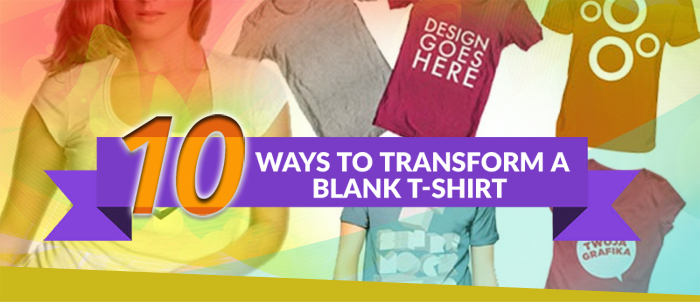
Ever since T-shirts became a fashion statement in the 1950s, they have been undergoing a continual adjustment to match the fashions of the times. In the 60s, T-shirts were tie-dyed for a one-of-a-kind originality. In the 70s, lots of sparkles and sequins of the early 70s glam rock T-shirts gave way in later years to the torn and worn look of punk. And, of course, T-shirts and the 90s grunge scene went hand-in-hand.
In recent years, there have been no significant changes in T-shirt fashions. What has changed is how T-shirts are produced and our awareness of the need to recycle them. These days consumers are just as concerned with how to reuse an item most effectively as they are with how the item is manufactured and who is manufacturing it.
For this reason, T-shirts have become a valuable material in the DIY crafting community. Because most people have so many T-shirts, DIY designers are using them more and more in creating gorgeous pillows, rugs, footwear, baby slings, and other items. Even quilting and jewelry artists are utilizing T-shirts to add a new essence to their creations.
Blogs and entire websites have been dedicated to reusing and recycling this valuable and yet common piece of apparel. Here is a list of the most creative, most popular, and most valuable ways to transform a T-shirt.

 Adding Color and Contrast
Adding Color and Contrast
When considering how to transform a blank T-shirt, one of the first ideas that naturally comes to mind is to produce an image on the cloth.
Aside from very involved process of silk-screening and standard fabric printing, there are many techniques that can be used to add a design to or alter the color of a blank T-shirt.
Using fabric paint and a brush is the traditional method for adding a distinctive and permanent design to a T-shirt. The obvious advantage of this method is that no sophisticated tools are necessary, so the design is limited only by how well the image is executed by the designer.
One of the most inventive ways to create a design is not to add color to the T-shirt, but to remove it. Used on a colored, but blank, shirt, a bleach pen will remove color everywhere it touches. Because of its convenient size, the bleach pen also allows a lot of freehand expression. A designer can “draw” a lack of color using this tool, which creates a really stunning affect.

 Flip Flops and Espadrilles
Flip Flops and Espadrilles
Flip flops offer a great opportunity for transforming a T-shirt into fashionable footwear. With only a pair of scissors, a bit of glue, and a wide variety of T-shirt colors, bargain-basement flip flops and espadrilles can be color-coordinated with a particular outfit. It’s also a great way to reuse flip flops whose original straps and fasteners are worn or broken.
Espadrilles are created by cutting a thick-soled flip flop and inserting two different sizes of T-shirt strips through the openings. A wide band is used for the toe and a narrower longer band for the tie that fastens around the ankle. Multi-colored versions can be made by using alternating colors for toe and ankle bands.
Blank white T-shirts provide an excellent background for embellishing these espadrilles. Embroidery, beadwork, sequins, and fabric flowers can be used to decorate the wide toe band.Flip flops needing new straps can be revitalized by weaving or braiding narrow-T-shirt strips. A five-strand braiding technique yields a ribbon of T-shirt “rope” that is both attractive and sturdy. These also can be woven with a pattern by varying a number of colors. The soft T-shirt braid also provides a comfortable stretch in the flip flop strap that loops around the back of the ankle. To help secure the ankle strap, two loops of T-shirt fabric are placed in the side holes near the heel.

 Bracelets and Bangles
Bracelets and Bangles
One unique way to give new life to both old bracelets and discarded T-shirts is to make chunky woven and knotted bracelets. Whether they are worn singly or several at a time, these bracelets can be fashionable or funky, depending upon the whim of the designer and the wearer.
These soft knotted and woven bracelets are created with several familiar techniques. Finger-knitting is commonly used to make the woven bracelets and, as its name implies, the only equipment needed is a pair of hands. T-shirts are cut into strips of varying width. The diameter of the woven or knotted bracelets is increased or decreased, according to the width of the strip.
The knotted bracelets are constructed with more of a macramé technique, using a variety of knots to give the bracelet texture and depth. Bangles and cuffs provide a solid foundation for wrapped T-shirt bracelets. The size of the bracelet depends on the size of the bangle, but the possibilities for textures and colors are limited only by the types of T-shirts on hand.
The wrap pattern around the bracelets provides a texture and depth not normally found in bangle bracelets, which usually have a smooth surface. Cuffs that are wrapped with T-shirt strips can be outstandingly dramatic, especially when the T-shirt strips are tied in decorative knots.

 Fabric Ornaments
Fabric Ornaments
T-shirts can be used to make some amazing fabric items. From flowers to pom-poms, T-shirt material has the flexibility and soft texture for making beautifully delicate fabric ornaments.
To create “carnations” made of fabric, T-shirts are cut into wide strips and then stitched with a large basting stitch down the center of each strip. These strips are then gathered (by pulling on the basting stitch), rolled into a flat spiral, and then glued to a small circle of T-fabric.
With this fast and easy method of flower-making, designers can make bouquets ranging from small to large flowers, as well as feature those flowers in a wide range of colors.
Pom-poms are also made with strips of T-shirt fabric, but the fabric is used in an entirely different way. Using two pieces of cardboard in the shape of a “C,” very narrow bands of T-shirts strips are wrapped around the C-shaped piece, binding them together. Designers then cut around the outer perimeter of the “C,” cutting the loops. Another narrow piece of T-shirt is tied around the center, and the pom-pom is finished. Because they are so soft and touchable, these pom-poms are lovely enhancements to baby toys and clothing. They are also great additions to hats and holiday decorations.

 Woven and Knitted Items
Woven and Knitted Items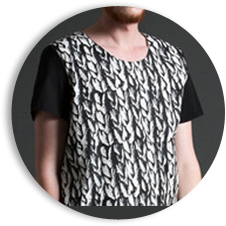
T-shirt “yarn” is a wonderful way to create unique household objects. It also offers some special advantages to knitted and crocheted items.
The “yarn” is created by cutting T-shirts into strips of a predetermined width, a width which varies from project to project. For example, the strips used for weaving are much wider than the strips used for knitting, crocheting, or hand-knitting.
Some string, a peg loom, a pile of T-shirts, and a free Saturday afternoon can result in a beautiful weaving of colorful T-shirt yarn. In turn, these weavings can be transformed into beautiful pillows, pot holders, wash cloths, and a large number of other household objects.
T-shirt knitting and crocheting yarn is produced by using a T-shirt that has no side seam. After cutting the T-shirt into a series of long 1-inch strips, the “yarn” is formed by rolling it through the fingers and then rolling it into a ball.
Although this narrow T-shirt yarn can be used solely to knit or crochet an entire piece, using it in combination with other types of yarn provides an intriguing contrast in stitch size and color. The overall effect is one of contrasts in the knitted textures, but they are contrasts that still harmonize with the rest of the piece.
Larger T-shirt yarns have been used on giant knitting needles to produce knitwear garments with oversized stitches. This dramatic stitch adds a wonderful textural design to sweater and vest knitwear.

 Shopping Bags
Shopping Bags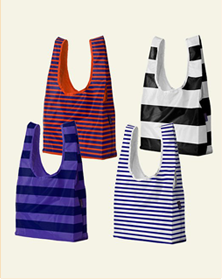
Shopping bags are one of the most necessary household items, but certainly not an object usually associated with T-shirts. As it turns out, T-shirts are marvelous materials for making shopping bags. The stretchy material is perfect for expanding when there is a need to hold more items.
T-shirt shopping bags can be extremely simple and fast to make. With a little more effort, they can rival the looks and appearance of classic crocheted shopping bags.
A T-shirt can be turned into a shopping bag in less than 20 minutes, and with no sewing. Cutting out the collar creates the bag opening, and cutting off the sleeves creates the outer edge of the bag handle. All that remains is to make a drawstring bottom, by threading some T-shirt “string” through the hem and drawing it closed.
A more sophisticated version of the T-shirt shopping bag requires a ruler, some precision cutting, a sewing machine, and a free hour. The extra effort results in a truly striking lattice bag that is perfect for carrying produce. And, because these net-like bags are so light, multiple bags can be used during a shopping trip.
These “net” bags also make great beach bags because they’re capable of carrying all sorts of odd-shaped objects. However, the best aspect may be that the “net” in the bottom of the bag holds all the beach goodies without holding all the beach sand.

 Belts and Headbands
Belts and Headbands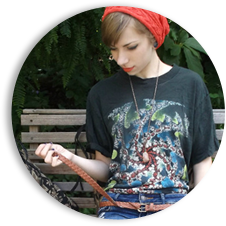
Braided belts made of T-shirts are colorful, striking, and extremely easy to make. Using a four-strand braiding technique with wide T-shirt strips creates a broad, flat braid that is also thick. In a sense, the braid has a classic belt shape.
After the braiding process, one end is sewn around a set of D-rings, and the other end is sewn shut with a simple seam. And, voilá! A belt is born.
This four-strand braid can also be used to create headbands. After creating a shorter piece of the four-strand braid, the ends are simply sewn together and covered with a band of T-shirt material to hide the seam.
Another favorite is the no-sew headband for heads of all sizes, and it can be made in a few minutes. Simply cut the T-shirt into one rectangle that is large enough to go around the head, and another much smaller one to wrap the seam.
The two shorter sides of the large rectangle are brought together and sealed with fabric tape. The seam is gathered, and then covered with the small rectangle, which is also sealed with fabric tape.
Other designers use twisted strands of T-shirt material to create a multi-strand head band. Four strands are cut into a rectangle that is measured to fit the wearer’s head, with the strands remaining attached at the top. Each strand is twisted individually, which gives them the appearance of a separate headband that is being worn along with three other individual headbands.

 Scarves
Scarves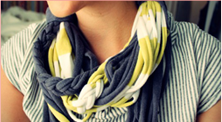
T-shirts make great scarves. With a pair of scissors, a bit of sewing, and some attention to detail,
T-shirts can quickly make the transition into innovative neckwear.

 Infinity Scarf
Infinity Scarf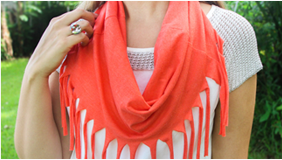
A T-shirt infinity scarf is perhaps the simplest of T-shirt scarves and is certainly one of the easiest to make. With two snips of the scissors and two across the body of the shirt, an infinity scarf is produced—including two smooth and rolled outer edges that make it look “finished.”
Of course, the length of the infinity scarf is based upon the size of the T-shirt. Oversized T-shirts are great for creating longer infinity scarves that can be double- or triple-looped to create a muffler effect or cowl neck.

 Rope Scarf
Rope Scarf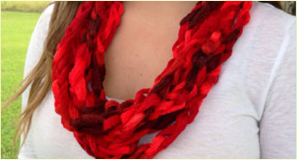
Another type of T-shirt scarf is a rope scarf. It consists of a single thin strip of T-shirt material that has been rolled into a soft, narrow tube. Wearing half a dozen or more of the ropes scarfs at the same time gives a layered affect.

 Neck Fringe Scarf
Neck Fringe Scarf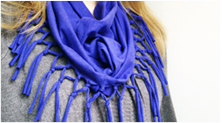
The neck fringe scarf is more whimsical. The neck is cut out of the T-shirt, surrounded by a circle of fabric that reaches from shoulder to shoulder. When cut from the T-shirt, this round piece resembles those circular breastplates seen in ancient armor.
Designers create the T-shirt fringe by cutting very small strips that are attached only at the neckline. These small strips are then individually twisted to make the strands of fringe more round in shape.

 Skirts
Skirts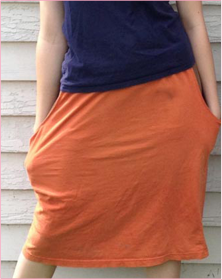
Whether a skirt is intended for a child or an adult, a T-shirt can always be used to craft an attractive and distinctive skirt.
Looking for a casual summer skirt? With only a few scissor snips (and no sewing!), a T-shirt can change into an extremely comfortable, fits-almost-everyone, simple skirt that’s perfect for the summer heat.
A scissor cut is made under one arm, across to the other arm. A second cut is made 1 inch from the first, generating a 1-inch strip. Rolling the 1-inch strip produces the drawstring for the skirt. After making a cut in the hem and attaching a safety pin to the drawstring, the drawstring is threaded through the hem and brought back out of the same opening, completing the construction. It’s now ready to wear!
Leftover T-shirt scraps from other projects can be used to produce a fringed skirt for little girls. A “foundation” skirt is first made from a T-shirt, using a T-shirt material cord pulled though the hem to create a drawstring. The rest of the shirt is cut to the desired length, and long cuts are made to a point about 3 inches below the waist.

 Slashes and Bows
Slashes and Bows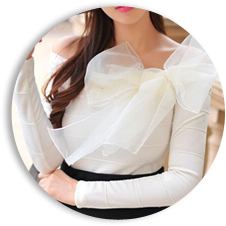
One of the beauties of working with T-shirts is that, in many instances, the only necessary design tool is a pair of scissors.
With a few strategically placed snips and little or no sewing, a T-shirt can become a unique and eye-catching piece of clothing. Cutting narrow fringe strips into the bottom of a T-shirt allows designers to use an intricate series of knots to create a lacey pattern in the fringe. And, with just a pair of scissors, a long-sleeved T-shirt can quickly be changed into a sleek, summer halter top.
Both scissors and rotary knives are commonly used to cut designs and slashes into a T-shirt. No matter if the cuts are a few slashes intended for a punk rock look or a series of small cuts in a beautifully intricate design, the cuts have one thing in common. Once the material is pulled after cutting, the pulling creates a permanent space, making a pattern appear.
Other designers love using scissors to create bows and ties at strategic points. For instance, altering the sleeves on a T-shirt provides enough material to change the shirt into a tie-sleeve tank top. For those wanting a more feminine touch, when making a sleeveless shirt, detached sleeves can be used to create big bows that cap the shoulders.
There are literally thousands of uses for the T-shirt, and this number will only increase in the future! With the ongoing popularity of the T-shirt, consumers will continue to buy them, continue to discard them, and continue to look for other uses for them.



